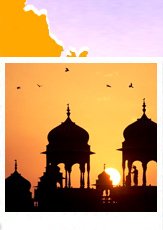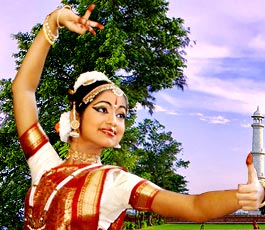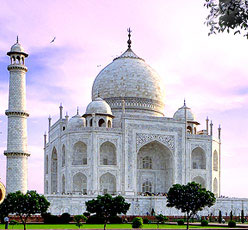Goa was a part of the Mauryan Empire,
around third century BC. The Satvahanas of Kolhapur, and the Chalukyas of
Badami, took over the governance later. Other dynasties followed, including
a short-lived Muslim invasion, until the Vijayanagar Empire established
itself for almost a century. This era ended with the arrival of the Sultans
of Gulbarga, from whom the rule passed on to Adil Shah of Bijapur. Soon, the
Dutch, English, French and Portuguese, all began struggling for its
possession. Ultimately, in 1510, the Portuguese conquered Goa, with Alfonso
de Albuquerque leading the invasion. Having ruled for around four centuries,
in 1961, fourteen years after the country's independence, the Portuguese had
to leave Goa. Tourist influx started in Goa in the 60s and 70s of 20th
century with hippies, the spoiled children of western materialism. Behind
them came the explorers, and at the end the mass tourist traffic. With
opening of Goan skies for chartered flights, number of holidayers increased
exponentially in the 1980 and 90 and growth in numbers is still continued.
In 1987, Goa was conferred statehood and Daman and Diu was made a separate
union territory.
Goa Culture
In spite of remaining under Portuguese control for so long, majority of the
people in Goa are still Hindu. Though, strong catholic influences are
visible everywhere in the art, culture, and society. The demography of the
state started changing after the coming of the Portuguese in the 15th
century due to the spirit of propagating Catholicism they brought with them.
Arts and Crafts of Goa
The art and craft forms of Goa show a remarkable harmony between Portuguese
and Indian cultures. The crafts of the state are intricately beautiful,
capturing the fancies of tourists and locals alike. These crafts can be at
best described as a mirror of Goa's perennial glory and beauty and they have
carved a niche for themselves with the connoisseur's of art the world over.
The major art forms of the state include bamboo craft, woodcarving, brass
metals, seashell craft, papier-mâché, and wooden lacquer ware.
Other important crafts of the state include jute macramé, fabric
collage, plaster of Paris, crochet and embroidery, fiber and batik prints,
fiber stone carving, coconut shell carving, metal embossing, silver and
imitation jewelry, cotton dolls, soft toys, woolen tapestry, and artistic
weaving.
Music and Dance of Goa - The ultimate experience
At the end of the day's work and before the evening meal, it is a common
practice for the young and old to join together in singing devotional songs.
Some of these were set to classical ragas and has to be sung to their proper
discipline to timing and notes, and thus they served as an introductory
course in the appreciation of the higher forms of classical music. Christian
music in the Goa originated out of the Church and the Goan music as one
knows today is only this form of music. Every village has a band of its own.
In the evenings, with the sipping of glass of wine, the sound of a piano
fills the night air of the strings of a guitar plucked in tune to a twilight
melody.
In terms of dances, Goa is extremely rich for both its traditional folk
dances as well as the new generation western dances. Some of the prominent
dances of the state include Bhandad, Corredinho that are Portuguese folk
dances, the Beauty Dance called Dekhni, apart from Fugdi and Dhalo, Ghode
Modnti, Kala and Dashavatar, Lamp Dance, Tonvamel, and Morulem.
Festivals of Goa
Though for visitors, Goa always looks in the mood of celebrations with
people singing and dancing even in their daily lives. But on a more formal
note, due to the strong Roman Catholic influences, most of the festivals of
Goa are Christianity-specific. Feast days, thanksgiving, monsoon
celebrations, processions; all mark the Goanese festival calendar. Shigmo,
the Goanese version of Holi, is celebrated in the month of February/March.
The Feast of Our Lady of Miracles, celebrated 16 days after Easter, is
secular by nature and is celebrated with pomp and gaiety by both Hindus and
Christians. Then the Carnival in Goa is a non-stop 3-day festival of color,
song and music, providing a healthy entertainment for all, young and old.
The soothing climate, full of fun- 'n' -frolic, which the Carnival
generates, is much longed for. It does not matter whether one enjoys or see
others enjoying. There is enthusiasm and happiness all around. Igitun
Chalne, held at Sirigao temple in Bicholim during May, is one of Goa's most
distinctive festivals. The main attraction of the festival comes when
devotees of Goddess Lairaya walk across burning coals to prove their
devotion. The Feast of St. Anthony in the month of June is also significant
as it marks the beginning of monsoon. Besides such religious festivals, Goa
is also known for its arts and crafts fairs, and food festivals.
Goa - Attire
Among on all states of India, Goa has a distinct style in every sphere of
life. The people of the state have taken life as it comes and that spirit
distinguishes them from others. One peculiar sight in Goa is that of skirts
outnumbering saris on the roads, due to strong Portuguese influences.
Traditional clothing also has its importance in this society and Konkani
women, wearing the sari in a style that is quite different from any other
place in India, can be still seen in great numbers.
Goa - Cuisine
Goa is a gourmet's paradise, with the overall quality of food being
excellent. Seafood in particular is a gastronomic treat. The winter months
have a bounty of Crayfish, Tiger Prawns, Squid, Mussels, Mollusks, and Crabs
as well as Fish. On the beaches itself and in the villages adjoining them,
many local families run tiny hotels and restaurants. In addition to seafood
cooked in the local as well as Western styles, there are Chicken, Beef and
Pork dishes. Some local dishes worth a mention are Chicken Xacuti, Cafreal,
Pork Vindaloo, Sarapatel, Fish & Prawn Caldiline, Reichado and Balchoo.
Large proportions of dishes and deserts contain coconut in them. Some sweet
Goan temptations include Bebinca, a layered sweet, Doce, Ale Bete, Bathique,
Cocado and Bulinos.
Feni is Goa's famous contribution to the world, the drink prepared from
cashew apples. Feni preparation is in fact a cottage industry in Goa and
feni is brewed in many a house. Other alcoholic drinks are cheaper here
compared to the other states in India.
India's travel agent and tour operator offering Goa travel information, tourism in Goa and Goa tours and travel packages.









